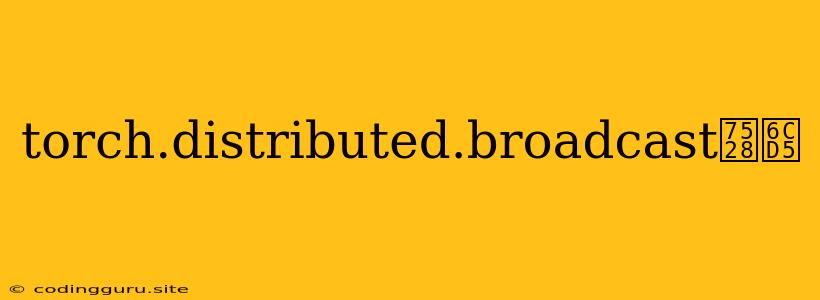Understanding torch.distributed.broadcast in PyTorch
In the realm of distributed deep learning, efficient data communication between multiple nodes is crucial for faster training and improved performance. PyTorch provides a powerful distributed framework that enables parallel computation across multiple devices, including GPUs and TPUs. A fundamental building block within this framework is the torch.distributed.broadcast function.
What is torch.distributed.broadcast?
torch.distributed.broadcast is a collective communication operation in PyTorch's distributed package. Its primary purpose is to efficiently replicate a tensor from a single process (the root process) to all other participating processes in a distributed training setup. This allows all processes in the training cluster to access the same data, a prerequisite for performing synchronous updates on models distributed across multiple nodes.
Why is torch.distributed.broadcast important?
- Model Weight Synchronization: In distributed training, each process might hold a copy of the model's parameters.
torch.distributed.broadcastis used to synchronize these weights across all processes after each training iteration, ensuring consistency and preventing divergence. - Sharing Data Structures: Besides model weights, you can broadcast other data structures, like gradients, optimizer states, or even custom objects. This allows you to share information efficiently throughout your distributed training pipeline.
- Simplifying Communication: Instead of implementing low-level communication protocols,
torch.distributed.broadcastprovides a high-level abstraction, making it easier to manage data flow across multiple devices.
How does torch.distributed.broadcast work?
- Initialization: You begin by initializing PyTorch's distributed framework using
torch.distributed.init_process_group. This sets up the communication backend (e.g., MPI, Gloo, NCCL). - Root Process: One process is designated as the "root" process. This is where the tensor to be broadcast originates.
- Broadcast Operation: The
torch.distributed.broadcastfunction is called by all processes, specifying the tensor to be broadcast, the root process rank, and the communication group. - Data Replication: The root process sends the tensor to all other processes in the group, ensuring that every process receives a copy.
- Result: All processes now have an identical copy of the tensor, enabling coordinated operations like model parameter updates.
Code Example: Broadcasting Model Weights
import torch
import torch.distributed as dist
# Initialize distributed environment
dist.init_process_group("gloo", rank=0, world_size=2)
# Define a tensor (representing model weights) on the root process (rank 0)
tensor = torch.ones(4)
# Broadcast the tensor to all processes
dist.broadcast(tensor, src=0)
# Verify the tensor is the same on all processes
print(f"Process {dist.get_rank()}: {tensor}")
# Cleanup
dist.destroy_process_group()
Key Points:
- Rank: Each process in the distributed system is assigned a unique rank, used to identify the root process.
- Communication Group: The
torch.distributed.broadcastoperation occurs within a specific communication group, which defines the processes involved in the communication. - Tensor Type: The tensor to be broadcast should have a compatible data type across all participating processes.
Tips for Efficient Usage:
- Choose Appropriate Communication Backend: The choice of communication backend (e.g., Gloo, NCCL) depends on your hardware setup and network topology.
- Minimize Broadcast Operations: Frequent broadcasts can introduce overhead. Optimize your code to reduce unnecessary broadcasts by using alternative strategies like parameter averaging or asynchronous updates.
- Consider Data Size: Large tensors can significantly impact broadcast time. Optimize your data structures to minimize the amount of data being broadcast.
Conclusion
torch.distributed.broadcast is a powerful tool in PyTorch's distributed toolkit, enabling seamless data replication and synchronization across multiple processes. Understanding its capabilities is crucial for building efficient distributed training pipelines that leverage the power of parallel computing. By mastering the use of torch.distributed.broadcast, you can effectively distribute your training workloads, achieving faster convergence and improved model performance.
